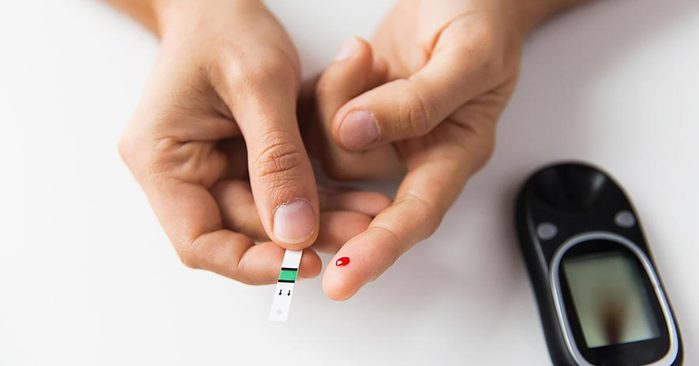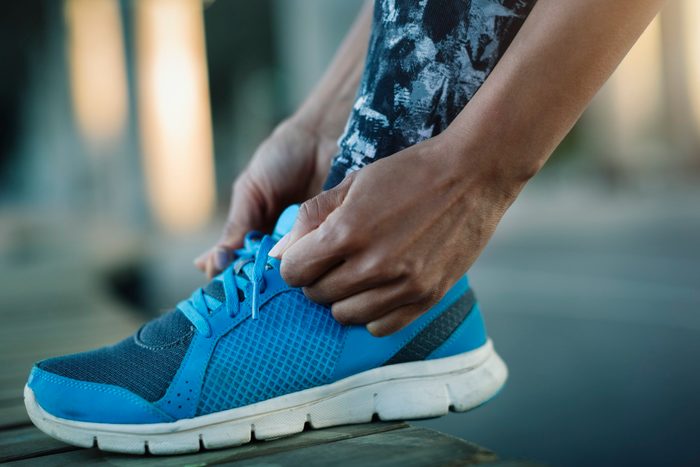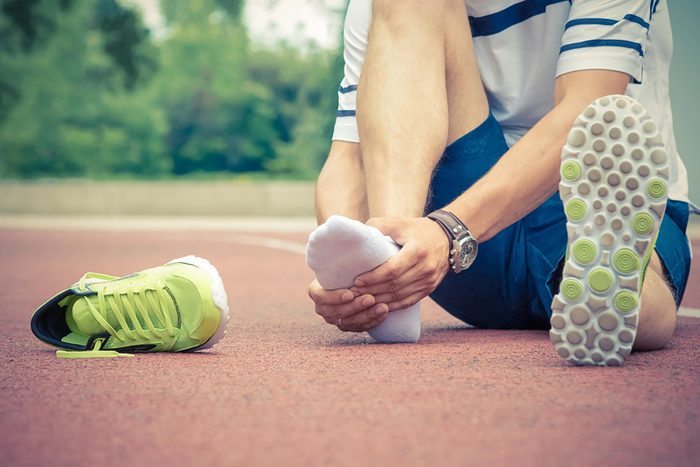
How far, how fast?
If you have type 2 diabetes, exercise probably ranks high on your to-do list. After all, the benefits of exercise for diabetes—for most health conditions, for that matter—are that it can help keep your weight under control and regulate your blood pressure. The added benefits of exercise for diabetes extends to lowering blood sugar levels and helping the body effectively use insulin, which controls blood sugar.
But before you start an exercise routine, you need to get the OK from your doctor, decide on what’s an appropriate exercise routine and level for you, and follow a few of our expert tips to get the most of your workout while staying safe and healthy.
Small losses, big gains
“Because most people diagnosed with type 2 diabetes are overweight, meal planning and physical activity usually focus on gradual weight loss, something on the order of two to three pounds per month, ” says Paris Roach, MD, an endocrinologist with Indiana University Health and the division of endocrinology and metabolism at the Indiana University School of Medicine. “Exercise is beneficial to metabolism independent of weight loss in that it lowers glucose levels and improves insulin resistance,” says Dr. Roach. Just a 5 to 10 percent reduction from your starting weight can have significant effects on blood glucose levels. That’s good news if you haven’t broken a sweat in a while. In addition, you’ll also gain muscle strength, improve cardiovascular fitness, flexibility, balance, stamina, mood, and overall good feeling.
(Related: Yes, You Can Manage Type-2 Diabetes With Exercise)

Keep an eye on blood sugar
Exercise will not only help control blood sugar levels but also help you shed weight and keep your heart healthy. It’s important you keep an eye on your blood sugar because any physical activity makes you more sensitive to insulin. “When you exercise, your body becomes more efficient at using insulin and this can lower blood sugar, both during exercise and up to 24 hours after,” says Mark Heyman, clinical psychologist, founder and director of the Center for Diabetes and Mental Health, and vice-president of clinical operations and innovation at One Drop, a mobile app that educates and coaches diabetics. Because blood sugar can drop dangerously low, check it before you exercise and again if you feel light-headed or weak during exercise, he says. “If your blood sugar is low (below 70mg/dl), eat 15 grams of simple carbohydrates, such as orange juice, glucose tablets, or candy,” says Dr. Heyman.
(Related: 7 Ways to Maintain Healthy Blood Sugar Levels)
Time your exercise schedule
If you’re taking short-acting insulin or short-acting oral medications that are designed to be active only around mealtimes, you may want to talk to your doctor about your exercise schedule. According to Dr. Roach, some people may need to decrease the doses of those medications when they exercise within a few hours of a meal to guard against hypoglycemia. On the other hand, if you are taking long-acting insulin or once-daily oral medication, these are generally active during all or most of a 24-hour period. “People who use those medications may want to fuel up with a small amount of carbohydrate before exercise, especially for activity that will last longer than 30 minutes, and they should check their blood glucose frequently during longer exercise sessions,” says Dr. Roach. Another thing to consider in an is the option of working out briefly after a meal to tamp down blood sugar—which typically rises eating.
(Related: 25 Reasons Why Cutting Back On Sugar Could Better Your Health)

Managing hypoglycemia
Since symptoms can vary from person to person, Rachele Berria, MD, PhD, vice president and head of U.S. Diabetes Medical Unit, Sanofi, says the only way to know for certain if you’re struggling is to test blood sugar levels. Based on the American Diabetes Association recommendations for treating hypoglycemia, Dr. Berria suggests these steps:
- Have at least 15-20 grams of fast-acting carbohydrate (like a sports drink, regular soda or glucose tablets)
- Wait 15-20 minutes and check your blood glucose again. If it is still low and your symptoms of hypoglycemia don’t go away, repeat the treatment
- After you feel better, be sure to eat regular meals and snacks as planned to keep your blood glucose level up
- If it is still low after repeating the treatment, consult your healthcare provider
(Here are the symptoms of hypoglycemia Diabetes Canada wants you to be aware of.)
Know the symptoms
Although hypoglycemia is more common with people who have type 1 diabetes, anyone living with diabetes, type 1 or type 2, should know these symptoms before they start an exercise program:
- Feeling shaky
- Feeling tired/weak
- Confusion
- Sweating
- Anxious or nervous feeling
- Hunger
- Nightmares
- Irritability
- Rapid heartbeat
- Headache
Some of these symptoms, like sweating or a rapid heartbeat are common when you’re exercising so it may be hard to recognize if you’re experiencing hypoglycemia. “It’s important for people who take insulin or other blood sugar-lowering medications to always check blood sugar before and after exercise, and sometimes during exercise, especially if they notice symptoms,” says Dr. Heyman.
(Related: This Simple Lifestyle Change May Help You Better Manage Your Diabetes)

Gym bag essentials
If you’re headed to the gym or a Zumba class, it’s always a good idea to stash some potentially life-saving essentials in your bag. A medical ID bracelet will give bystanders the critical info needed to help you. On a piece of paper in your wallet, write down emergency phone numbers, health conditions, medications you take, and the name and number of your healthcare provider.
Also, keep carbohydrate snacks like candy, dried fruit, or dry cereal handy when you experience low blood sugar. A glucagon injection kit will be vital if low blood sugar causes a seizure or unconsciousness. Dr. Roach highly recommends carrying fast-acting glucose whenever you exercise or are away from home. “Foods such as candy and raisins, for example, are not as reliable as pure glucose tablets and gels in terms of raising the blood glucose quickly and may not contain enough sugar to get the job done,” Dr. Roach warns. Finally, stash an extra water bottle. With everyone needs to be hydrated when exercising, type 2 diabetics staying hydrated with water can help keep blood sugars in the target range.
Eating the right snacks for the type of activity
More strenuous activities like jogging can lower blood sugar levels more dramatically. Sensible eating before working out can make a difference. “Slower digesting carbs and/or carbs with a side of protein can help stabilize blood sugars ahead of exercise,” says Rachel Head, RD, certified diabetes educator at One Drop. Head suggests banana slices with peanut butter, apple slices with almonds, or Greek yogurt for pre-workout snacks. “The amount will vary based on how long and how intense the activity is, as well as whether the medication will be at peak effectiveness at the time of activity.”

How often and how long you should exercise
Before you lace up your sneakers, discuss your exercise plans with your doctor. “Physical activity programs should begin slowly and build up gradually,” says Dr. Berria. The American Academy of Clinical Endocrinologists suggests type 2 diabetics get at least 150 minutes a week of moderate-intensity exercise such as brisk walking or an equivalent. Flexibility and strength training are also encouraged. If doing 30 minutes in one session sounds daunting, no worries. You can spread it out over the course of the day. “Engaging in 10-minute activities three times a day is as effective as continuous exercise, and may make weekly exercise goals feel more manageable,” says Dr. Berria. Any way you look at, exercise will help you fight and lower your blood sugar.
Managing target heart rate
Medications for lowering blood pressure such as beta-blockers can influence metabolism and exercise tolerance. “No matter how hard you exercise when taking a beta-blocker, you may never reach your target heart rate, says Neelima Chu, MD, an endocrinologist at Sharp Rees-Stealy in San Diego. When you’re exercising and want to hit that target heart-rate zone, Dr. Chu recommends gauging it by making sure you can talk while you’re exercising. Whether you’re pumping iron or even taking a brisk walk, you’re probably overdoing it if you can’t hold a conversation without feeling out of breath.
(Related: 14 Benefits of Walking for Just 15 Minutes)

Keep tabs on your feet
“Peripheral neuropathy or foot pain can be a complication of poorly controlled diabetes but it doesn’t happen with every diabetic,” says Dr. Chu. This foot condition is the result of damaged nerves from chronically elevated glucose levels. If you have this condition, you can still exercise. Just be sure to wear comfortable shoes that are wide enough so you’re not compressing your feet. Your toes should wiggle freely when you’re trying them on. A podiatrist can make recommendations for special diabetic shoes and inserts.
Also, check your feet every day for any cracked or dry skin. Diabetic foot care like looking for any pressure points, blisters or areas of warmth and redness,” says Dr. Chu. If there is too much nerve damage, you may no longer experience pain so you may not realize you have an infection or trauma. “Untreated injuries and ulcers can lead to amputations.” Choose your activities carefully if you have peripheral neuropathy. “Avoid activities like running, where balance is important, and choose something like swimming instead,” suggests Dr. Heyman.
Protect your eyesight
If you have eye problems related to uncontrolled diabetes, you likely will have to limit or avoid certain types of activity. For example, you should steer away from strenuous strength training or high-impact exercise. Dr. Berria says these activities could strain blood vessels in the eyes of patients with retinopathy, causing issues like eye damage or bleeding into the eye.
(Related: Fenugreek: Can This Ancient Healing Seed Help Treat Diabetes?)
Baby steps to feeling better!
Managing type 2 diabetes may seem like a tiresome task, but as you begin to manage your blood pressure, you will feel better. “Physical activity does not need to be complicated,” says Andrea M. Sosa-Melo, MD, physician and educator at Pritikin Longevity Center + Spa. “A daily brisk walk can help you live a healthier life.” Remember, that 10-minute increments are just as effective as a full-length session. Dr. Melo encourages wearing a pedometer. “Put it on in the morning and see how many steps you take in an average day, and then try to increase that number each week.” Check out these easy-to-accomplish ideas from Dr. Melo:
- Get off the bus one stop earlier
- Walk to the store, post office or library
- Stand up and move around while talking on the phone
- Take the stairs instead of the elevator
- Take walk during lunch or other work breaks
- Walk your dog
- Walk with your kids or a walking group
- Don’t stay seated for more than 30 minutes (you can walk in place during a Netflix binge!)
Next, learn about the worst eating habits for diabetics.
